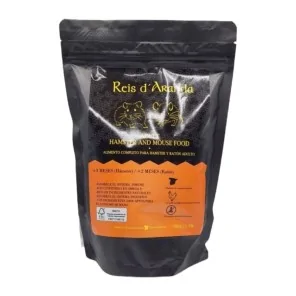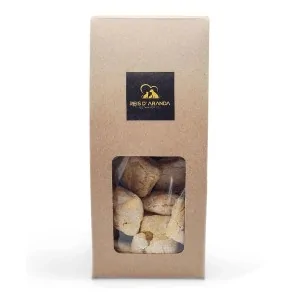Its name says it all: the Vienna blue rabbit comes from Austria. Not only is it beautiful with its shiny blue-grey...
TYPES OF DOMESTIC AND WILD HAMSTERS
DOMESTIC AND WILD HAMSTERS
Surely, when you read the word hamster you think of two hamster options: a chubby, red-haired and white one, like the picture below, or a small grey one, more like the picture on the left, right? Well, surprising as it may seem, there are many, many species of "hamsters"; yes, "species", because "hamsters" do not have breeds.
Many of the hamsters that we can find in pet shops or on internet sales platforms are what we know as "hybrids" and there are few that we can find that fit well in the regulations and characteristics of their species.
Below, we will look at some of the different species we can find:
SPECIES OF DOMESTIC HAMSTERS
SYRIAN HAMSTER
The Sirian hamster is a robust species, with large eyes, tulip-shaped ears and a very short tail. Their body measures approximately 13 to 15 centimetres long (although some specimens can reach a slightly larger size), and they weigh between 120 and 180gr. The "Sirian" have four different types of coat:
-Short
-Long (Angora)
-Satin
-Rex
They can be very attached to their owners, so they should be given a lot of attention and if they cannot spend time with them, they should be given a lot of toys to keep them amused, otherwise they will be very unhappy.
DWARF WINTER WHITE RUSSIAN HAMSTER
Also called "Russian winter dwarf hamsters" or "Djungarian dwarf hamsters", this species is native to the northern steppes of Kazakhstan and Siberia. The coat of this type of hamster can be a beautiful shaded grey/black (the usual colouring in the wild), smoke grey with sapphire highlights and pearl white with coloured marbled tips. Nowadays you can find specimens in other colours such as tangerine, orange or brown, but specialists state that these are not pure "Winter White Russians", but crosses of this species with "Campbells". Winter White Russians measure between 7 and 11 centimetres and weigh between 35 and 50 grams. They are generally quite friendly and gentle if they have been well socialised from an early age, and are more manageable than other hamster species. Unlike the others, this species can live in same-sex groups and is introduced to all of them at an early age, but not later, as it can be dangerous.
CAMPBELL'S RUSSIAN DWARF HAMSTERS
The "Campbell" is closely related to the "Winter White Russian" (also called "Russian") and, although it is one of the most popular as a pet, it is not able to unseat the "Russian" and, for this reason, is more difficult to find in pet shops. They originate from Russia and northern China and have a beautiful brownish coat with a thin line running down the whole of the spine and head to the forehead; in the winter months it can become slightly greyish. With a size between 6 and 12 centimetres long and a weight of 30 to 50 grams, its adorable appearance hides a character that can become really aggressive at specific moments or, if it has received an incorrect socialisation.
ROBOROVSKI HAMSTER
The "Roborovski" is perhaps the most striking of all the short-tailed dwarf hamsters. With a size of 5cm and a weight between 20 and 25gr, this little creature has a beautiful cream-tan coat with grey tones (without dorsal stripes) and really striking whiskers that differentiate it from the rest without problems; besides it has a barely visible tail that gives it a special touch of tenderness. They are the most popular pet of all the "hamster" species, which is accentuated by their sociable, docile and very active character. As with the "Russian", the "Roborovski" can live in groups formed by specimens of the same sex as long as they have lived together since they were small, avoiding the introduction of new specimens in the future for the safety of the new hamster. This species is one of the least breeding of all.
CHINESE HAMSTER
Long-tailed species. Affectionate with its owners, the "Chinese" measures between 10 and 12 centimetres and weighs about 45 grams, the male being slightly larger than the female. Because of its physical characteristics, the "Chinese" is classified as a "rat hamster" (along with six other species), being the only species of hamster that has a long, prehensile tail, and is more like a mouse than a hamster. It is an adorable and wonderful pet because of its size and personality, but it is not at all common in pet shops and is generally little known. In some US states (California and New York) they are considered a pest, so a number of permits are required to breed, sell or keep them as pets.
SPECIES OF WILD HAMSTERS
MONGOL HAMSTER
The "Mongol" is a species of wild hamster native to China and Mongolia. It is a wild animal that cannot be domesticated and is not currently endangered.
They are considered a pest in some areas and it seems that their favourite food is rice. The largest "Mongol" hamster captured weighed 25kg.
EVERSMANN'S DWARF HAMSTER
Also called "Kazakh Hamster", it inhabits the steppes of Kazakhstan (from the northern Caspian Sea to western Mongolia). In size, the "Eversmann" is quite similar to the "Sirius", measuring between 14 and 16 centimetres and with a tail of between 2 and 3 centimetres. Its coat is reddish-brown with a greyish-white belly. Its diet is based on seeds, various cereals and insects. It is a wild species and cannot be domesticated.
VULGAR HAMSTER
Also called "European Hamster" or "Rye Pig", this species of hamster is the largest of all, with a length of between 20 and 35 centimetres and a weight of up to 900gr. The "Vulgar" hamster is native to central and eastern Europe, where it is considered a real crop pest. Solitary and master of building the most intricate burrows, its diet consists of seeds, legumes, vegetables and grasses. It is currently a "critically" endangered species and, although it is quite rare to find as a pet, it is possible to domesticate it, reaching a life expectancy of up to 8 years with proper care.
SOKOLOV'S DWARF HAMSTER
This species is very little known and lives in the semi-desert lands of China and Mongolia. Due to the characteristics of the areas they inhabit, their diet is mainly insectivorous, although they supplement it with seeds and sprouts. It is not a domestic species and its habitat is, in most cases, in protected areas.
TURKISH HAMSTER
One of the closest relatives of the "Syrian hamster". This species of hamster was first catalogued in 1878 and is native to Turkey, Armenia and neighbouring nations. Nocturnal in nature, unlike many other "hamsters" the "Turk" hibernates and its burrows are sufficiently well adapted and stocked to keep it in this state for between four and ten months; hibernations of 30 days, waking for one or two days, are the norm. Their diet is very varied, but the main staple is cereals, grasses and occasionally insects. They are considered a crop pest.
ROMAN HAMSTER
Very similar to the "Sirius", this type of hamster is native to Bulgaria and Romania. Its habitat consists of arid areas, grasslands and rocky steppes although it can be seen frequenting areas inhabited by humans in search of food, such as gardens or crop fields, being very similar in this respect to all the other "hamsters". Because its habitat is threatened, the Romanian hamster is in possible danger of extinction, although Romanian law has begun to protect it. Its fur is brown and white (belly), reaching a length of 17.78 centimetres and a weight of between 80 and 115gr.
CAUCASIAN GOLDEN HAMSTER
Another species closely related to the "Syrian hamster", the "Caucasian Golden" is also known as the "Georgian hamster". Native to Russia and the northern steppes of the Caucasus, it lives from Dagestan to the Sea of Azov, including the Don River and parts of Georgia (the country that gives it its other name). It is a mainly nocturnal creature and feeds on grains, shoots and seeds, which it accumulates for the winter after hibernating for an average of five months. It is 27-29 centimetres long, has a very short tail and mixed brown and black fur with white markings, as well as a curious dark central pattern. The Caucasian Golden breeds very little compared to other rodents, with an average of two litters per year.
CONCLUSION
Knowledge is power, and even more so when it comes to the living beings with which we share our daily lives; knowing our hamsters and their cousins of other species is important to better understand their nature and the characteristics that make them up. Always remember to get information from the best professionals.
Leave a comment
Log in to post comments
Comments
Bom sítio para aprender
By: Guillermo G. On 05/15/2024Um artigo bem escrito, aprende-se muito neste sítio.
:O No sabía esto
By: Lorena On 05/15/2024No sabía k abía tantos hammys, yo creía k solo estaban los comunes y los enanos. Muy interesante, saludos desde Perú
Me ha gustado
By: Raquel On 05/15/2024Bonito artículo, muy interesante
















